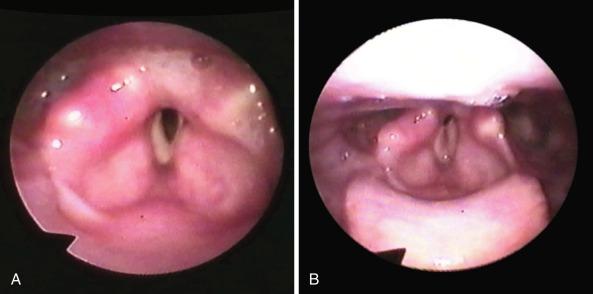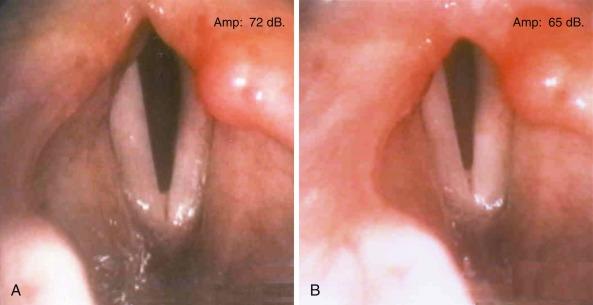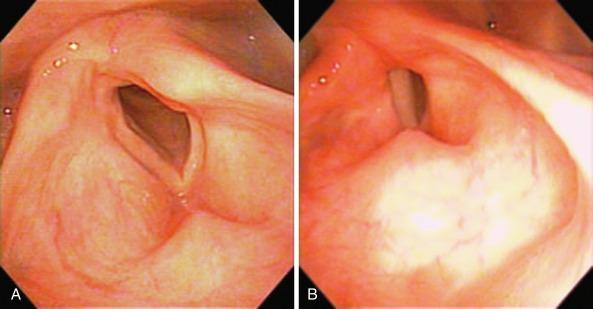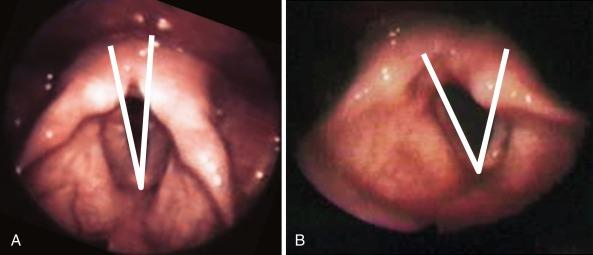Physical Address
304 North Cardinal St.
Dorchester Center, MA 02124
Laryngeal nerve injury is a serious complication of thyroid surgery. Unilateral injury impairs the voice and, occasionally, swallowing. Bilateral injury can result in life-threatening airway obstruction. Symptoms vary greatly over time and between patients, depending on the site and severity of the lesion and the biology of the healing process. This chapter deals with the pathophysiology of recurrent laryngeal nerve (RLN) injury and the biology of nerve regeneration (see Chapter 43 , Management of Recurrent Laryngeal Nerve Paralysis).
Unilateral laryngeal paralysis can be completely asymptomatic, an incidental finding during the course of a routine laryngeal examination in a patient with a normal voice. Patients with acute laryngeal nerve injury virtually always have some voice impairment, ranging from mild vocal fatigue to severe hoarseness, depending on the degree of nerve damage. In the most severe cases, the glottis is incompetent, resulting in aphonia and even aspiration during swallowing. Laryngeal paralysis can impair all functions that require tight glottal closure, such as cough, defecation, and stabilization of the thorax for heavy lifting. Unilateral paralysis can cause stridor in infants. Otherwise, one mobile vocal fold usually provides an adequate airway. But some patients experience episodic airway obstruction due to laryngospasm. In some cases, the paralyzed vocal fold adducts during inspiration, resulting in stridor or even warranting a tracheotomy.
It has long been observed that vocal function can improve, even if a vocal fold remains immobile. The position of the paralyzed vocal fold tends to shift toward the midline over time. It is now apparent that this change in position is due to reinnervation of adductor muscles.
When both RLNs are injured, vocal symptoms take a back seat to respiratory issues. Acute bilateral paralysis can require emergent tracheotomy or intubation. Other patients may have a marginal but adequate airway. As in unilateral paralysis, symptoms change over time due to reinnervation of laryngeal muscles ( Figure 42.1 ). A weak and breathy voice may become stronger as the airway becomes worse. Patients frequently have some appropriate adduction with phonation, but abductor function is rare. Inappropriate adduction with inspiration can also occur, sometimes because of a passive inward collapse of flaccid paralyzed musculature during inspiration (e.g., the Bernoulli effect), sometimes as a result of inappropriate contraction from synkinetic reinnervation ( Figure 42.2 ).


The severity of vocal symptoms is related to the distance of the paralyzed vocal fold from the midline. The voice is weak when the glottis cannot close completely during phonation, and it becomes breathy or aphonic when the glottic gap is large. Surgical procedures such as thyroplasty and vocal fold injection move the anterior portion of the paralyzed vocal fold nearer the midline. This effectively restores vocal function in patients with a paramedian vocal fold position. But when the arytenoid is externally rotated, the paralyzed vocal process is too far lateral to permit approximation by the mobile contralateral vocal process ( Figure 42.3 ). In such cases, adequate closure of the glottis requires surgery that addresses the posterior portion of the vocal fold as well.

The terms median and paramedian have traditionally been used to describe a paralyzed vocal fold that lies at or near the midline. A more abducted position is referred to as cadaveric. An alternative to using the terms paramedian or cadaveric is to measure the angle formed between the vocal folds during inspiration. A line is drawn from the anterior commissure to the vocal process on each side. Together these lines form the anterior glottic angle. This parameter is a quantitative measure that is useful in preoperative assessment and in tracking the results of treatment. Figure 42.4 illustrates the glottic angle in two patients: one with a vocal fold paralyzed in the paramedian position and the other in a more lateral position.

Over the years, many explanations have been postulated for the variation in the appearance of the larynx in unilateral paralysis and the shift in position over time. The two theories with the most historical significance are Semon’s law and the Wagner-Grossman hypothesis. Semon postulated that in the progression of nerve injury, nerve fibers to the abductor muscles were affected first, so that the glottal opening would be impaired first. Later, adductor muscles would also become paralyzed, and the vocal fold would move laterally. However, Semon’s law actually predicts that the affected vocal fold will shift laterally over time. This is exactly opposite to the gradual adduction that has been so widely observed for many years. The Wagner-Grossman hypothesis asserts that after an RLN injury, the vocal fold is adducted by the cricothyroid muscle, the only intrinsic laryngeal muscle that is not supplied by the RLN. After a high lesion of the vagus nerve injury, both the recurrent and superior laryngeal nerve fibers are affected. Therefore the Wagner-Grossman hypothesis predicts that without the adductor force of the cricothyroid, the vocal fold would lie in the cadaveric position. Because it is more consistent with clinical observations of the vocal fold position in RLN and vagus nerve injuries, the Wagner-Grossman hypothesis has been widely accepted for many years.
But the preponderance of experimental evidence has dispelled the notion that the cricothyroid muscle adducts the vocal fold. Although it is true that the cricothyroid muscle behaves as an accessory muscle of inspiration, recruited by increased inspiratory effort, blockade of the nerve to the cricothyroid muscle has no influence on glottic area or transglottic resistance, even during stimulated breathing with maximal cricothyroid activity. Simulated cricothyroid muscle contraction in cadaver larynges results in vocal fold lengthening but no adduction. A three-dimensional model of vocal fold motion supports this finding.
Many clinical series have failed to confirm a correlation between the position of the vocal fold and innervation of the cricothyroid muscle. Instead, vocal fold position is determined by the forces of reinnervated (or residually innervated) muscles. In a study of 114 patients with a fixed vocal fold, Hirano found electromyographic (EMG) activity in 65%. Vocal fold position correlated with the number of motor units detected in the thyroarytenoid muscle by EMG and not with the status of the cricothyroid muscle. In another study of patients with laryngeal paralysis, resulting from known sites of nerve injury, the position of the paralyzed vocal fold was quantified by measuring the angle formed by the vocal folds during prephonatory inspiration. A narrower glottic angle (i.e., a medial position of the paralyzed vocal fold) was observed in patients with greater EMG activity of the thyroarytenoid muscle. In addition, the arytenoid tilts forward in patients with little or no detectable EMG activity. This anterior tilt has been attributed to loss of tonic support from the posterior cricoarytenoid (PCA), a muscle that is not often sampled in EMG studies.
The PCA muscle is regarded as the sole abductor muscle in the larynx, but computer modeling suggests that the interarytenoid muscle participates in abduction. Further, the PCA muscle does not function solely as an abductor. It is also active in phonation, providing posterior support to the arytenoid and counterbalance to the anterior tipping forces exerted by the adductor muscles and the cricothyroid muscle. Indeed, in total laryngeal paralysis, the arytenoid tips forward due to the loss of this support.
EMG activity in a clinically paralyzed vocal fold can represent residual innervation after an incomplete original injury. It may also represent reinnervation of the muscles, either from a regenerated RLN or by sprouting from other nerve sources.
Become a Clinical Tree membership for Full access and enjoy Unlimited articles
If you are a member. Log in here